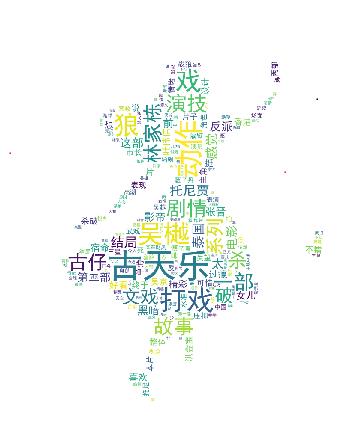python大作业
Posted alive
tags:
篇首语:本文由小常识网(cha138.com)小编为大家整理,主要介绍了python大作业相关的知识,希望对你有一定的参考价值。
词云---利用python对电影评价的爬取
一、抓取网页数据
1:网页爬取一些数据的前期工作
from urllib import request
resp = request.urlopen(\'https://movie.douban.com/nowplaying/hangzhou/\')
html_data = resp.read().decode(\'utf-8\')
:2:爬取得到的html解析
from bs4 import BeautifulSoup as bs soup = bs(html_data, \'html.parser\') nowplaying_movie = soup.find_all(\'div\', id=\'nowplaying\') nowplaying_movie_list = nowplaying_movie[0].find_all(\'li\', class_=\'list-item\')
在上图中可以看到data-subject属性里面id,而在img标签的电影的名字,两个属性来获得电影的id和名称。
nowplaying_list = []
for i in nowplaying_movie_list:
nowplaying_dict = {}
nowplaying_dict[\'id\'] = i[\'data-subject\']
for tag_img_item in i.find_all(\'img\'):
nowplaying_dict[\'name\'] = tag_img_item[\'alt\']
nowplaying_list.append(nowplaying_dict)
二、数据的处理
comments = \'\'
for k in range(len(eachCommentList)):
comments = comments + (str(eachCommentList[k])).strip()
三、词云生成图片
import matplotlib.pyplot as plt
%matplotlib inline
import matplotlib
matplotlib.rcParams[\'figure.figsize\'] = (10.0, 5.0)
from wordcloud import WordCloud#词云包
wordcloud=WordCloud(font_path="simhei.ttf",background_color="white",max_font_size=80)
word_frequence = {x[0]:x[1] for x in words_stat.head(1000).values}
word_frequence_list = []
for key in word_frequence:
temp = (key,word_frequence[key])
word_frequence_list.append(temp)
wordcloud=wordcloud.fit_words(word_frequence_list)
plt.imshow(wordcloud)
付源码
# -*- coding: utf-8 -*-
import warnings
warnings.filterwarnings("ignore")
import jieba # 分词包
import numpy # numpy计算包
import codecs # codecs提供的open方法来指定打开的文件的语言编码,它会在读取的时候自动转换为内部unicode
import re
import pandas as pd
import matplotlib.pyplot as plt
from PIL import Image
from urllib import request
from bs4 import BeautifulSoup as bs
from wordcloud import WordCloud,ImageColorGenerator # 词云包
import matplotlib
matplotlib.rcParams[\'figure.figsize\'] = (10.0, 5.0)
# 分析网页函数
def getNowPlayingMovie_list():
resp = request.urlopen(\'https://movie.douban.com/nowplaying/hangzhou/\')
html_data = resp.read().decode(\'utf-8\')
soup = bs(html_data, \'html.parser\')
nowplaying_movie = soup.find_all(\'div\', id=\'nowplaying\')
nowplaying_movie_list = nowplaying_movie[0].find_all(\'li\', class_=\'list-item\')
nowplaying_list = []
for item in nowplaying_movie_list:
nowplaying_dict = {}
nowplaying_dict[\'id\'] = item[\'data-subject\']
for tag_img_item in item.find_all(\'img\'):
nowplaying_dict[\'name\'] = tag_img_item[\'alt\']
nowplaying_list.append(nowplaying_dict)
return nowplaying_list
# 爬取评论函数
def getCommentsById(movieId, pageNum):
eachCommentList = []
if pageNum > 0:
start = (pageNum - 1) * 20
else:
return False
requrl = \'https://movie.douban.com/subject/\' + movieId + \'/comments\' + \'?\' + \'start=\' + str(start) + \'&limit=20\'
print(requrl)
resp = request.urlopen(requrl)
html_data = resp.read().decode(\'utf-8\')
soup = bs(html_data, \'html.parser\')
comment_div_lits = soup.find_all(\'div\', class_=\'comment\')
for item in comment_div_lits:
if item.find_all(\'p\')[0].string is not None:
eachCommentList.append(item.find_all(\'p\')[0].string)
return eachCommentList
def main():
# 循环获取第一个电影的前10页评论
commentList = []
NowPlayingMovie_list = getNowPlayingMovie_list()
for i in range(10):
num = i + 1
commentList_temp = getCommentsById(NowPlayingMovie_list[0][\'id\'], num)
commentList.append(commentList_temp)
# 将列表中的数据转换为字符串
comments = \'\'
for k in range(len(commentList)):
comments = comments + (str(commentList[k])).strip()
# 使用正则表达式去除标点符号
pattern = re.compile(r\'[\\u4e00-\\u9fa5]+\')
filterdata = re.findall(pattern, comments)
cleaned_comments = \'\'.join(filterdata)
# 使用结巴分词进行中文分词
segment = jieba.lcut(cleaned_comments)
words_df = pd.DataFrame({\'segment\': segment})
# 去掉停用词
stopwords = pd.read_csv("stopwords.txt", index_col=False, quoting=3, sep="\\t", names=[\'stopword\'],
encoding=\'utf-8\') # quoting=3全不引用
words_df = words_df[~words_df.segment.isin(stopwords.stopword)]
# 统计词频
words_stat = words_df.groupby(by=[\'segment\'])[\'segment\'].agg({"计数": numpy.size})
words_stat = words_stat.reset_index().sort_values(by=["计数"], ascending=False)
# print(words_stat.head())
bg_pic = numpy.array(Image.open("alice_mask.png"))
# 用词云进行显示
wordcloud = WordCloud(
font_path="simhei.ttf",
background_color="white",
max_font_size=80,
width = 2000,
height = 1800,
mask = bg_pic,
mode = "RGBA"
)
word_frequence = {x[0]: x[1] for x in words_stat.head(1000).values}
# print(word_frequence)
"""
word_frequence_list = []
for key in word_frequence:
temp = (key, word_frequence[key])
word_frequence_list.append(temp)
#print(word_frequence_list)
"""
wordcloud = wordcloud.fit_words(word_frequence)
image_colors = ImageColorGenerator(bg_pic) # 根据图片生成词云颜色
plt.imshow(wordcloud) #显示词云图片
plt.axis("off")
plt.show()
wordcloud.to_file(\'show_Chinese.png\') # 把词云保存下来
main()

以上是关于python大作业的主要内容,如果未能解决你的问题,请参考以下文章